Every spring my 1/2 acre pond has a boom of FA. I do have 2 bottom diffusers for aeration and they do a great job keeping the pond healthy. Its normally just the initial snow melt and run off of from the fields that makes for a back breaking day of trying to rake it all out. I have used these(see below) before and would say they did a good job, but they are very expensive, especially if you had to get one every 30 days! Is there an alternative product I could buy you would suggest? And can I find it in NY, some places wont ship the chemicals here. Thanks. Below is the link to the product I mentioned.
http://www.northerntool.com/shop/tools/product_200381535_200381535
Well I can only tell you what worked for me was adding about 400 soft shell crayfish. Well they are soft shell when they molt. These little buggers eat a pile of FA. Way way more than I would have thought.
Cleared out pond up in under a year. Now I didn't have a problem but we did scoop it out by hand with a net year round when ever we were down there. Last year after having the crayfish multiply we never had to pull any FA out of the pond. The only place we see it is right near the feeder and that is to be expected with waste feed.
Cheers Don.
my experience with crawfish in a pond is limited to only the last 60 days but I can tell u that everywhere I added 100 to 200 crays the FA and the Grasses are gone and the bottom is clear of any vegetation. And the ones I added were 1/4 to 1" in size. I hope they make it but they r the perfect size for eating by my REs and CNBG.

Tracy
I'm very interested. Is there any down fall to using crayfish? Will they bother swimmers? I have YP, lmb, bg, res, 2cc and 4 we in pond if that helps.
Hey Benji,
I am not a pro but, based on the inputs I have read here on the forum, I can offer this.
1) The crayfish will not bother swimmers
2) Choose a crayfish variety, such as papershell, that will not burrow.
3) Without predators, crayfish will multiply and can remove most all the vegetation in the pond. You have predators from your post that will love crayfish so this is probably not a concern for you.
Crayfish will not thrive where there are adult bass predators and normal pond cover. Cover and habitat have to be very common to abundant for crayfish to thrive with sport fish present.
Will crayfish survive in a pond that is not well aerated?
Where do you get crayfish in SE Michigan?
Do they survive a winter freeze or are the annuals?
Thx
FWIW IMHO I would do a quick google search on crayfish endemic to your area and stock a non-burrowing one if possible. Make sure you have suitable habitat for them before you stock.
JWF,
A google search using crayfish and pondboss should show a couple of links on crayfish. One I think was put in the archives section. Bill cody could probably find it quicker than I could and post it.
There was a link to a crayfish forum where there was good pictures and ID of many crayfish.
As to finding them, probably best off grabbing them yourself in a local stream. Rolling over stones and using a net is pretty easy way to do it. Or if it is a small stream you can sometimes use a minnow seine and cross the creek and then roll stones over and let things flow downstream to the seine.
When at a local lake you can throw in a minnow trap (metal type with cones on each end) and if there are crayfish in the area they will go in the trap providing you bait with something they like. I found catching some minnows or a small bluegill and then chopping them up to release the innards is a terrific attractant for the crayfish.
We leave a trap over night in the lakes we visit with a carcase of a bluegill after it was fileted, by morning there are dozens of crayfish and only the very clean bones of the bluegill left in the trap.
I have not found a commercial source for papershell crayfish or other desirable crayfish close by.
Native crayfish are best and non-burrowing are best.
Many lakes in northern michigan have big populations of very aggressive rusty crayfish. They are easiest to catch but the jury is out yet on whether you want them in your pond. If their numbers get out of hand you will have no vegetation which is important for supporting the food chain (small critters hide in vegetation and support the middle section of the food chain between microscopic and minnow size)
So probably catching your own native ones is the best.
Will crayfish survive in a pond that is not well aerated?
Where do you get crayfish in SE Michigan?
Do they survive a winter freeze or are the annuals?
Thx
I am in Ontario Canada and we have a pile of crayfish in our pond. They will winter very well. I would expect they will live with out aeration. We seeded the pond with only 300 or so just an estimate and now when the water gets to 55 every rock along the shore has one under it. We can get two or three every night in the minnow trap.
This is the pictures of two totes of crayfish we added.
Cheers Don.
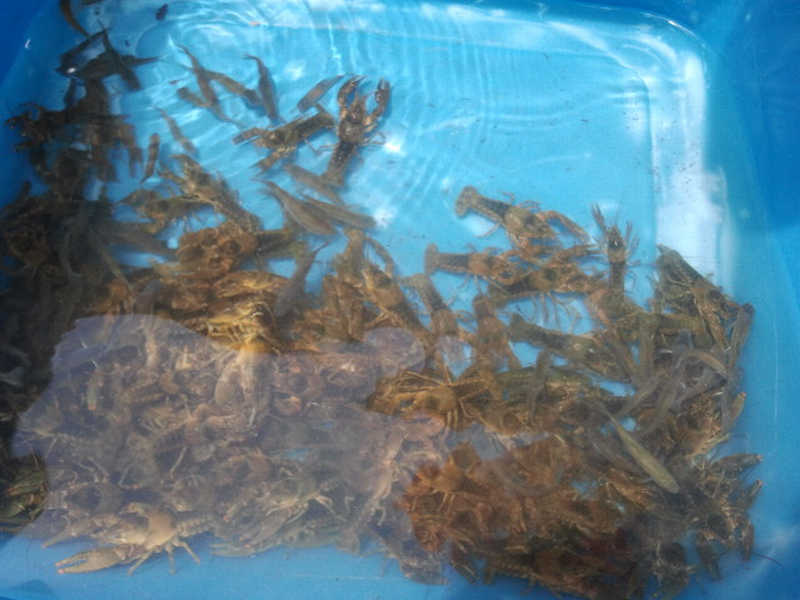
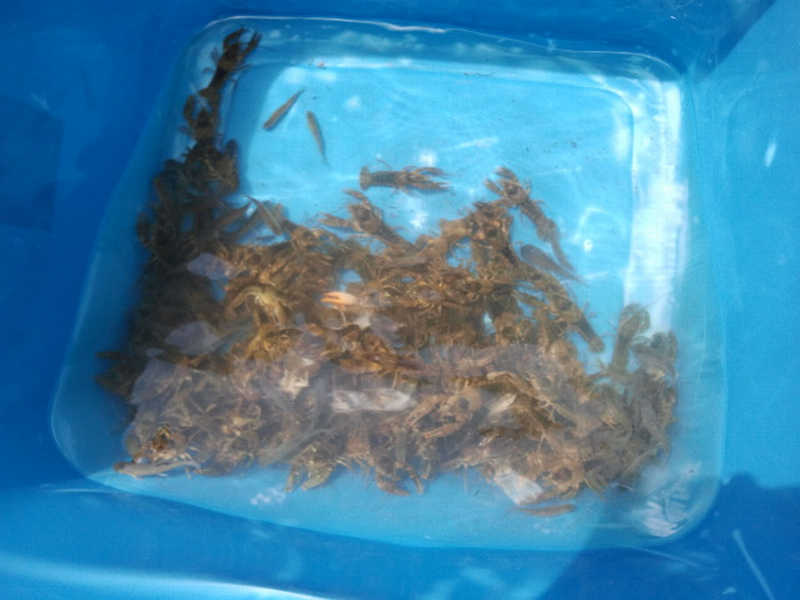
Many crayfish ponds are shallow and not aerated. Shallow pond usually mix top to bottom due to wind action. Crayfish in deep ponds without aeration will inhabit the top oxygenated zone or layer similar to the invertebrates and fish. Where in SE MI are you? There are a few papershell crayfish sources in NW Ohio.
JWF, see this link, top post in this link has other links in it to the crayfish helpful forums.
Crayfish links on PB forum
Just getting back to Pond Boss after starting this post about a week ago. Thanks for all the info - I now have to go study it all and see what is the next direction.
One of you guys mentioned there is a source for crawfish in NW Oh. Can you tell me where - it may be worth a road trip to know I am getting the right kind.
some places wont ship the chemicals here.
Cutrine Plus granules controls my FA and is easy to use.
e-Bay Cutrine Plus Granular  Before Cutrine Plus:
Before Cutrine Plus: 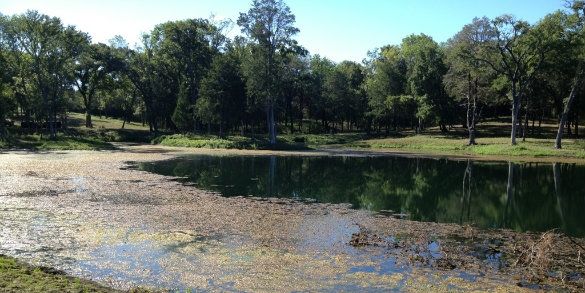 After Cutrine Plus:
After Cutrine Plus: 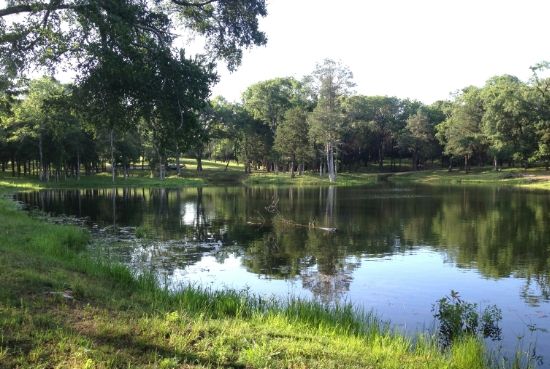
Zep, have you tried the Liquid?
From my reading I took it the granular worked good on FA that was growing on the bottom because they sink and the copper that is coated on the little gravel on the Cutrine Plus granules gets down where it is needed. The liquid is supposed to work well on the matted floating stuff. At least that was my take.
I used some of the granules a few weeks ago as the FA started up and it seemed to knock it back pretty good. Here recently it came on like gangbusters and before I knew it there were floating blobs around the edges. When I ordered, I ordered some of each so I had both on hand. This time I tried the liquid and sprayed it on (diluted down 9 to 1 as per instructions) with a hand sprayer. Only got it done yesterday so no report on how it worked yet.
Just wondering if you had experience with both forms of Cutrine, or just the granules.
I have not compared the amount of active ingredients in each, but if it is like any other chemicals I have had experience with, usually the liquid is a lot more concentrated and costs less per unit active ingredient.
Here is another thread on crayfish. It refers to my search for a suitable species specifically for my area, but it does describe the papershell variety.
Types of crayfish
Before Cutrine Crystals.
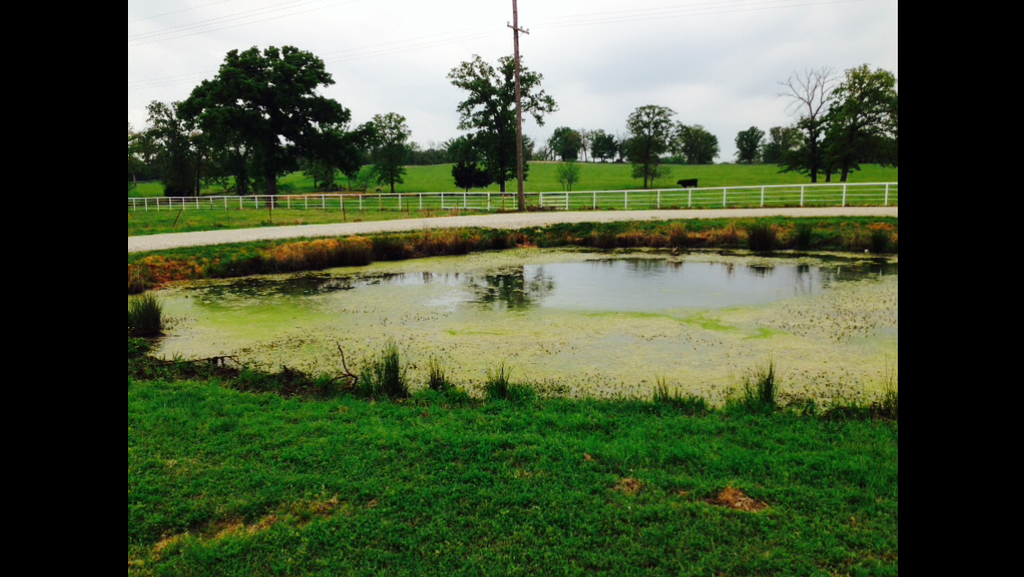
After Cutrine Crystals
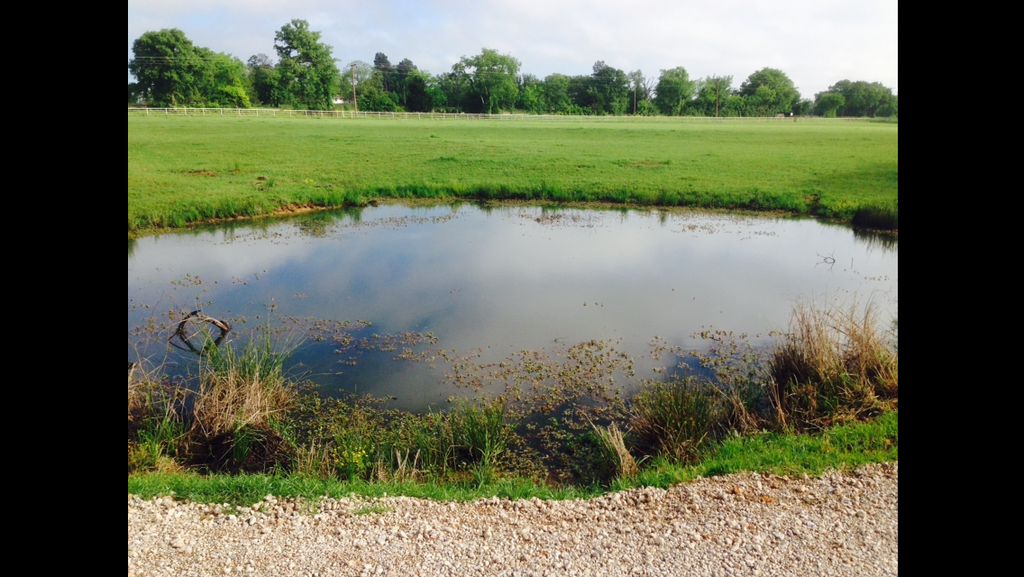
Zep, have you tried the Liquid?
I have only used the granules.
I don't own a sprayer...
and it just seems so easy pitching it out.
i put on surgical gloves and just throw it on
the floating mats of FA and it does a really good job.
Tbar....looking good!
How long does it take for that stuff to clean up the pond
Zep,
There is a distinct border to the algae growth in your pond. Does it correlate to a very specific depth? What would you estimate is your minimum bottom depth to be safe from algae? How much does that depth vary from your "clear water" years versus your "turbid water" years?
Thanks - Rod
How long does it take for that stuff to clean up the pond
...Cutrine Plus Granules work pretty quick
Some spots I had to treat a couple of times.
And some re-treatment towards mid-summer.
I guess it takes a week to ten days to notice it doing it's job.
It appears the sun/cutrine "burns" the FA...but I'm not sure.
Tbar how long did it take for yours to clear?
Zep,
There is a distinct border to the algae growth in your pond. Does it correlate to a very specific depth? What would you estimate is your minimum bottom depth to be safe from algae?
I believe FA is often associated with shallow gradual
sloping shorelines...and that is what I have. I wish my
shorelines had a steeper incline. Of course super steep
drop-off shorelines can be a danger to children or even
a pain for us to step off into deeper water. I am no expert
but I would guess water 4-6 feet deep starts being less prone
to FA.
I think the depth FA grows depends on how much sunlight reaches the bottom. I put Aquashade in last fall and it made a big difference on FA growing in deeper water, not so much around the shallow edge. I know the FA is still in the deep water because I drag up some on hooks occasionally but it seems no to be growing much. I use liquid Cutrine around the edge out to 2 or 3 feet deep and it usually takes 10 or 12 days for it to knock it way back. It really doesn't matter how much water you mix it in. The water is just a carrier. The important thing is, be sure to cover the area specified on the label with whatever ratio you mix. Also, do not treat the whole pond in one treatment if you have much FA. I treat 1/3 or so and wait a couple weeks to do another third, etc. I used granules once last year in deep water and didn't see much result as far as I could tell, but it was probably my fault for not spreading it heavy enough.
Took about a week for it to clean up my FA. I still need to work on some aquatic plants that are growing.
I still need to work on some aquatic plants that are growing.
Tbar I've had decent luck with Navigate Aquatic Herbicide
for the plants....but it's pricey stuff.
I need to work on my aquatic plants too.
 e-Bay Navigate Aquatic Herbicide
e-Bay Navigate Aquatic Herbicide
Also, do not treat the whole pond in one treatment if you have much FA. I treat 1/3 or so and wait a couple weeks to do another third, etc.
That's good advice poppy.
This is what I used to spread the granules around the edge of the pond. Worked pretty decent. Just pointed the direction of spread out towards the middle of the pond as I walked. Had wife drive along with 4 wheeler to refill me so did not have to walk back and forth to supply.
hand fertilizer spreader For the liquid I just used a 2 gallon hand pump up garden sprayer and diluted at 9-1 like the jug suggested for that method. Then sprayed the mats with the mixture. Drove the Polaris along side the pond while spraying out over the algae. Went pretty quick.
I sprayed the whole perimeter at once, but as a total amount compared to the total pond area it was only a fraction of the whole pond at one time. Hope it was not too much at once. I have aeration so that should help if the DO does try to drop.
I like the idea of getting some crawfish and am looking into sources for them in SE Michigan. I have some questions:
What is the down side of native crawfish - nonburrowing kinds?
What if you want to get rid of them at some point and don't have fish? How do you eliminate them? (I am a bit worried about introducing something that is not already there).
Off the topic of crawfish but still algae control - what is the effectiveness of mechanical removal of FA? I made an algae rake and have pulled most of the mats off the pond tonight. I am wondering if this is worth the labor?
Am I better off trying some of the algaecides before going to crawfish?
Appreciate all your inputs and suggestions.
Disadvantage to crayfish is if there are too many it will denude the pond of about all plant species and feeding activity will reduce the pond secchi disk clarity to 12". Without fish about the only way to eliminate over abundant crayfish is to use rotenone a fish toxicant. Trapping, seining and harvest can remove high numbers of crayfish, but definitely not all the brood stock. Best and easiest way to control them is to add bass. A strong population of panfish including YP will heavily reduce crayfish numbers especially young ones and after several years comparatively few crayfish will be present. Check your PM.
Manually removing FA is beneficial in that it removes all the nutrients that the algae absorbed for its growth. The more FA removed the more nutrients that are removed from the pond system thus reducing amount of FA that generally grows in the future. However, removing FA may not be enough nutrient removal to keep pace with the annual nutrient accumulation. It all depends. FA removal is worth the labor if you are concerned with chemical contamination of your pond - depending on the composition of the algaecide. Some algaecides are more environmentally friendly than others. Algaecides kill the algae (symptom) and decomposing algae recycle the bound nutrients (causative agent) back into the pond for more plant growth.
In searching algae I find many comments about nutrients that feed the algae and that it is important to control and limit the nutrients. I am not sure what is meant by nutrients and where they come from.
To me it sounds like it would be fertilizer run off or something like that but I do not have that and I have plenty of FA.
My pond is old an in bad health which I am trying to fix. It has been overgrown for years so there is a lot leaf material and muck, which I think is the decaying by product of years of leaves falling in the pond. Is this a source of the nutrients that feed FA?
I also think the pond is probably anaerobic which from what I have read may be because of the leaves and muck - is this right?
I had been thinking about getting some crawfish but I don't want to introduce a species not already there so I am thinking the following:
1) Mechanical removal of the FA mats on the surface.
2) Treat with some Cutrine
3) Introduce aeration
4) Rent a trash pump and suck out some of the leaves and muck
5) Introduce some bacteria
6) Rinse and repeat... :-)
What do you think?
JWF you are on the right track
-pond dye controls sunlight to shallow waters, keeps shallow weeds in control (but not right at the edge which you can mechanically remove)
-crayfish may work, but that should not be relied on. I would reserve crayfish for situations where you want lots of them to be a source of forage, and, only if you have enough predators to help control the numbers of young crayfish (bass/perch/panfish)
-chemicals do not sound attractive, but there are times where the growth of weeds is so beyond what can be managed by any other means that you either have to use chemicals or you have to use intense pond dye to block the energy source for the plants.
for muck - jury is out on healthy enzymes and bacteria. Lots of forums on this topick, pros, cons, cold water vs warm water, bacteria vs enzymes etc. I think mechanical removal of leaves and weeds, and mechanical stirring of the bottom with aeration will be more reliable.
aeration - depends on depth, access to power etc but can never go wrong, even in a shallow lake like mine where the temperature separation probably doesn't amount to much, aeration at least provides water flow/circulation.
Consider powered agitation of the bottom, rent a trash pump and use it like a power washer to agitate and break up the bottom, or use an outboard motor prop wash, jet ski output etc to mechanically stir up the bottom. This with aeration after will help.
I still struggle with ways to keep the leaves out of the pond but others have posted on this forum with ponds in the woods with heavy layer of leaves and no manual removal and have not had issues.
Nutrients and fertilizer.
It all depends on what you consider to be fertilizer. If you consider anything decaying to be fertilizer, then your pond is being fertilized continually.
Think of it as a large compost pile. Everything that falls into the pond is decomposed over time, and accumulates on the bottom.
The only way to remove nutrients is to remove them. That may sound funny, but it's true. Tilapia eat a lot of algae in a pond. When they die in the fall when the water cools down, many scavengers eat them, "removing" them from the pond. Raccoons, etc. Raking out the algae and weeds is another way to remove nutrients from the pond. BUT, they have to be put far enough away from the pond so that they don't decompose and leach back into the pond. Harvesting fish to eat is another way to remove nutrients. But, don't throw the fish carcass back into the pond - your goal in nutrient rich ponds is to remove nutrients, not add them back.
Phosphorous is a large part of the nutrient cycle, but for plants and algae to grow, they need nitrogen too. If there's enough nitrogen in the pond, and conditions are right, one pound of Phosphorous can grow up to 500 pounds of algae. Goose and duck poop are rich in nutrients. A single goose can poop one pound per day.
So, yes, you are on the right track of removing as many nutrients as possible, making sure that there is enough O2 at the pond bottom for bacteria to do it's thing, and reducing sunlight penetration into the water.
Some plants growing in a pond is a good thing - they use nutrients that would be feeding algae. Many plants are not - they reduce the useable area of the pond.
Nutrients and fertilizer.
It all depends on what you consider to be fertilizer. If you consider anything decaying to be fertilizer, then your pond is being fertilized continually.
I guess one has to choose words and thoughts carefully. Another way of looking at it would be
man made vs. nature made.
I would choose not to straight out remove the nutrients but tie them up with a tight bond. I expect all this alga is a good thing to a point where it is part of nature and has its place. To much of a good thing can be bad too.
Small life anywhere needs nutrients that are very fine and soluble. What greater place than water and warm water at that.
The alga is really tying up the nutrients in its cells of growth. In doing so it needs the building block of life Calcium, carbon, few amino acids to build the cell. The cell needs to go through a chemical break down like composting to break the chemical bond. Depending on the total composition and temperature what is left or released is different, but the nutrients end up back in the pond starting the cycle again. This is why the general and majority consensus is to prevent the nutrients from getting into the pond and manually pulling out the nutrients.
Sodium carbonate peroxyhydrate perfect in that it is aggressive in breaking the cell (hydrogen peroxide) but as well leaves soda ash behind to bond with the phosphates and nitrogen's. In basic terms sodium phosphate and sodium nitrate. I am sure there is some other impurity's but expect them all to be alkali in nature. Potassium phosphate, potassium nitrate, calcium phosphate, you get the point. This product is very aggressive and I expect can kill most anything if it is small enough in the concentration.
It is important to know that these bonds now are tight bonds. A PH swing or more aggressive nutrient needs to be in contact to break the bond making the one of the two elements soluble or free again. A plant will make its own chemical in its fine roots to break these bonds and absorb these nutrients. Small basic life needs soluble nutrients but more complex life not so much.
I have used calcium hydroxide in our pond for FA and pond dye to control it. Crayfish I expect are helping too. My point is that if you can tie up the soluble nutrients where a plant would have to create a chemical reaction to break the bond the FA will not be overly abundant. Taking out the light needed for FA will pull another leg out from under it.
Just with everything you don't want to over do it but bring the balance back. Taking out the FA manually is very labor intensive and allot of work. When it floats to the top I just sprinkle some calcium hydroxide on it and its gone in hours. The chemistry thoughts are that what free soluble nutrients the FA grew on I have added equal amounts of elements that will tie it up when it breaks down in the body of water somewhere.
This is just a petrol-chemical chemist talking and what seems to be working for me.
Cheers Don.











